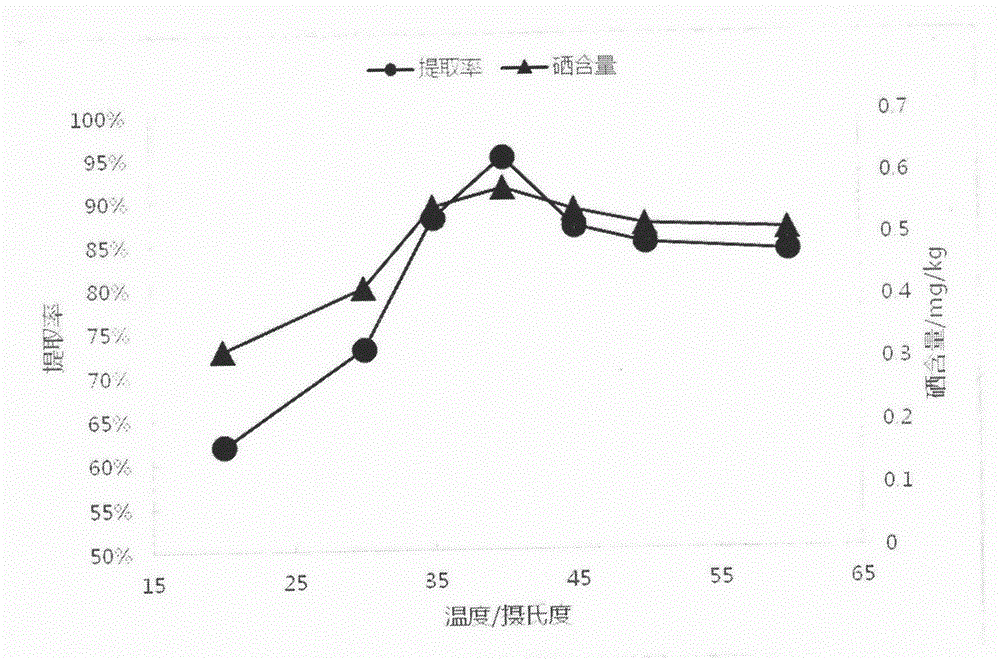Method for extracting selenoprotein from selenium-rich rice bran
A technology of selenium-enriched rice and selenoprotein, applied in the field of selenoprotein extraction, can solve the problems of less than 20% effective utilization rate of rice bran, high requirements for reaction conditions, and high process cost, and achieve wide extraction temperature range, good absorption effect, and high extraction efficiency. high efficiency effect
- Summary
- Abstract
- Description
- Claims
- Application Information
AI Technical Summary
Problems solved by technology
Method used
Image
Examples
Embodiment 1
[0030] (1) Raw material and processing: Wash the fresh selenium-enriched rice bran with distilled water, put it into an oven for drying; grind it with a rice huller, and pass it through a 100-mesh sieve.
[0031] (2) Dosing: prepare a sodium hydroxide solution with a concentration of 0.01mol / L, mix hydrosulfite and dithiothreitol in a mass ratio of 1:2 and add them to the sodium hydroxide solution, and the amount of hydrosulfite is as follows: (1) 0.5% of the mass of the prepared rice bran powder.
[0032] (3) Ultrasonic extraction: mix the rice bran powder prepared in step (1) with the extraction solution prepared in step (2) according to the ratio of mass to volume of 1:5, and put it into an ultrasonic cleaning machine for ultrasonic extraction, which greatly improves the extraction efficiency , set the extraction temperature to 35° C., the ultrasonic frequency to 100 Hz, and the extraction time to 3 hours to obtain an ultrasonic extraction solution.
[0033] (4) Decoloriza...
Embodiment 2
[0044] (1) Raw material and processing: Wash the fresh selenium-enriched rice bran with distilled water, put it into an oven for drying; grind it with a rice huller, and pass it through a 100-mesh sieve.
[0045] (2) Dosing: prepare a sodium hydroxide solution with a concentration of 0.04mol / L, mix sodium hydrosulfite and dithiothreitol in a mass ratio of 1:4 and add it to the sodium hydroxide solution, and increase dithiothreitol amount to extract more protein. The consumption of hydrosulfite is 0.5% of the quality of the rice bran powder that step (1) makes.
[0046] (3) Ultrasonic extraction: mix the rice bran powder prepared in step (1) with the extraction solution prepared in step (2) at a ratio of 1:10 in mass to volume, and increase the ratio of solid to liquid to make the extraction more complete. Then put it into an ultrasonic cleaning machine for ultrasonic extraction, the extraction temperature is 45° C., the ultrasonic frequency is 100 Hz, and the extraction time ...
Embodiment 3
[0055] (1) Raw material and processing: Wash the fresh selenium-enriched rice bran with distilled water, put it into an oven for drying; grind it with a rice huller, and pass it through a 100-mesh sieve.
[0056] (2) Dosing: prepare a sodium hydroxide solution with a concentration of 0.05mol / L, mix hydrosulfite and dithiothreitol into the sodium hydroxide solution in a mass ratio of 1:5, and the amount of hydrosulfite is as follows: (1) 0.5% of the mass of the prepared rice bran powder.
[0057] (3) Ultrasonic extraction: mix the rice bran powder prepared in step (1) with the extract prepared in step (2) at a ratio of 1:15 in mass to volume, further increase the ratio of solid to liquid, and extract selenoproteins more fully. Put the mixed solution into an ultrasonic cleaning machine for ultrasonic extraction, further adjust the optimal extraction temperature to 40°C, increase the extraction rate, ultrasonic frequency 100Hz, and extraction time 3 hours to obtain an ultrasonic ...
PUM
 Login to View More
Login to View More Abstract
Description
Claims
Application Information
 Login to View More
Login to View More - R&D
- Intellectual Property
- Life Sciences
- Materials
- Tech Scout
- Unparalleled Data Quality
- Higher Quality Content
- 60% Fewer Hallucinations
Browse by: Latest US Patents, China's latest patents, Technical Efficacy Thesaurus, Application Domain, Technology Topic, Popular Technical Reports.
© 2025 PatSnap. All rights reserved.Legal|Privacy policy|Modern Slavery Act Transparency Statement|Sitemap|About US| Contact US: help@patsnap.com



